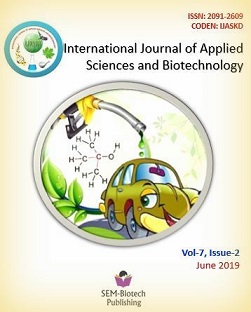Studies on Factors Affecting Pregnancy Rate after Treatment of Anestrus Buffaloes in Chitwan District
DOI:
https://doi.org/10.3126/ijasbt.v7i2.24645Keywords:
Oysynch, PregnancyAbstract
This study was designed to determine the effects of age, parity, feeding practice, Body Condition Score (BCS), blood nutritional parameters, types of anoestrus, and length of anoestrus on pregnancy rate of anoestrus buffaloes after their treatment with ovsynch protocol followed by fixed time artificial insemination. Blood samples were collected on the day ovsynch protocol and analyzed. The mean values of the nutritional parameters between different groups were compared by Students t test and pregnancy rate was compared by Fisher’s exact test or Chi-square test. The overall pregnancy rate in buffaloes was 28.6%, when checked on day 41 and 64.3% on day 102 of FTAI. Blood glucose, cholesterol, calcium and phosphorus level was found to be significantly higher (p<0.05) in pregnant than in non-pregnant buffaloes. Pregnancy rate was higher in silent estrus buffaloes. Buffaloes with BCS ≥3 had higher pregnancy rate than those with BCS < 3. Similarly, pregnancy rate was higher in lactating than in non-lactating buffaloes. While young buffaloes of age <10 year responded better than old buffaloes of age ≥10 year. Buffaloes which were free from gastrointestinal parasitic infection had higher pregnancy rate. In conclusion, ovsynch protocol produces a good pregnancy in anoestrus buffaloes; however, state of true anoestrus, older age and poor BCS with poor nutritional management adversely affect the pregnancy outcome. The role of blood nutritional parameters requires further clarification.
Int. J. Appl. Sci. Biotechnol. Vol 7(2): 248-256




